VARIOUS ARTISTS / “Mardi Gras Mixtape”
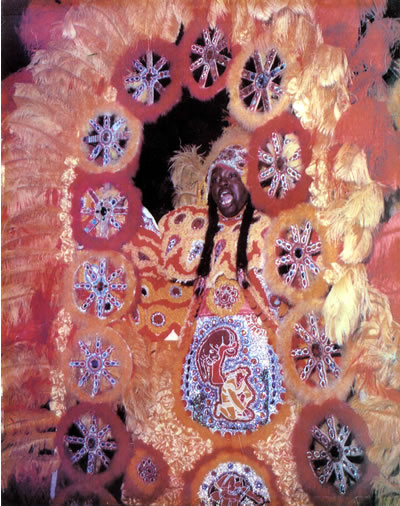
“We’re the soul of Mardi Gras” —Big Chief Bo Dollis, Big Chief, The Wild Magnolias Mardi Gras IndiansThis is the longest mixtape we’ve ever posted on BoL but not even one minute of the nearly two hours is boring. Rather than a detailed run down track by track I choose to make a handful of overall observations that I hope will help non-New Orleanians appreciate both the complexity and the beauty of this music, as well as understand the socio-political importance of the Mardi Gras Indians. The mixtape begins with a handful of classic Mardi Gras songs that are played every year. We never tire listening and dancing to this music. “Big Chief,” the opening selection, is composed by Earl King and features King’s whistling. Also in the mix is the percussive piano work of Professor Longhair, but it’s the distinctive drumming of Smokey Johnson that sets this song apart from every other Mardi Gras song. Note that African heritage rhythms are employed in all of this Mardi Gras music. Formally the drums sound out the rhythms but the drums are abetted by the rhythms of the other instruments as well as by the singing and chanting. There is not one straight four/four song in the 26 selections. It is also no accident that these songs are all associated with Mardi Gras Indians in one way or another. Thomas L. Morgan’s knowledgeable overview of recorded Mardi Gras Indian music is available here.
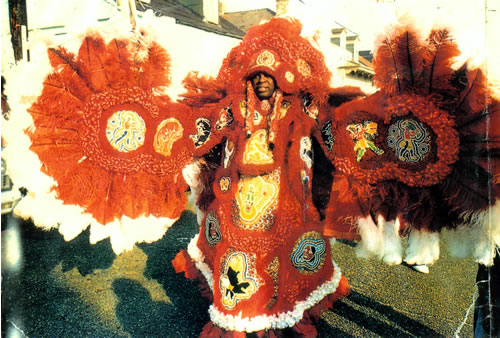 I believe Big Chief Bo Dollis is 100% accurate in stating that the Mardi Gras Indians are the soul of Mardi Gras. They have preserved and persevered as purveyors of self-determined culture with particular emphasis on sewing Indian suits, dancing and singing. The Mardi Gras Indians are directly responsible for a constant invigoration of New Orleans music in general and Mardi Gras associated culture specifically.
I believe Big Chief Bo Dollis is 100% accurate in stating that the Mardi Gras Indians are the soul of Mardi Gras. They have preserved and persevered as purveyors of self-determined culture with particular emphasis on sewing Indian suits, dancing and singing. The Mardi Gras Indians are directly responsible for a constant invigoration of New Orleans music in general and Mardi Gras associated culture specifically.
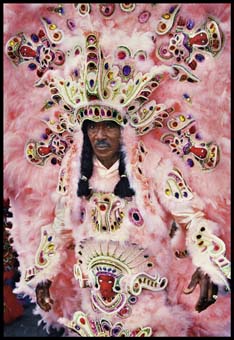 The colorful, hand-sewn Mardi Gras Indian suits are master works of artistic expression through handicraft. The most original and influential masker was Alison “Tootie” Montana, Big Chief of The Yellow Pochahontas who set a record of masking in a new suit for fifty straight years.
The colorful, hand-sewn Mardi Gras Indian suits are master works of artistic expression through handicraft. The most original and influential masker was Alison “Tootie” Montana, Big Chief of The Yellow Pochahontas who set a record of masking in a new suit for fifty straight years.
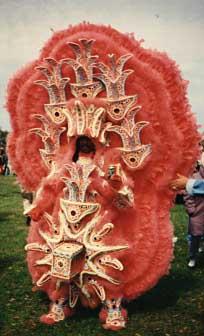 Tootie was a downtown Indian who changed the game. Before World War 2 the Indians from different sections of the city would physically fight each other to prove who was the best. Tootie transformed the fight from guns and knives to needles, thread and feathers. After Tootie the fight was to be the prettiest.
Tootie was a downtown Indian who changed the game. Before World War 2 the Indians from different sections of the city would physically fight each other to prove who was the best. Tootie transformed the fight from guns and knives to needles, thread and feathers. After Tootie the fight was to be the prettiest.
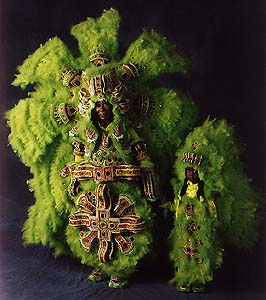 Tootie developed a unique style of suit designs that differed significantly from his uptown counterparts. The uptown Indians generally emphasized beadwork with representational motifs on their aprons and bibs. The beadwork was often a narrative.
Tootie and the downtown Indians developed a three-dimensional concept that was more abstract and featured geometric designs. Nobody was ever able to match, not to mention surpass Tootie’s suits.
Tootie developed a unique style of suit designs that differed significantly from his uptown counterparts. The uptown Indians generally emphasized beadwork with representational motifs on their aprons and bibs. The beadwork was often a narrative.
Tootie and the downtown Indians developed a three-dimensional concept that was more abstract and featured geometric designs. Nobody was ever able to match, not to mention surpass Tootie’s suits.
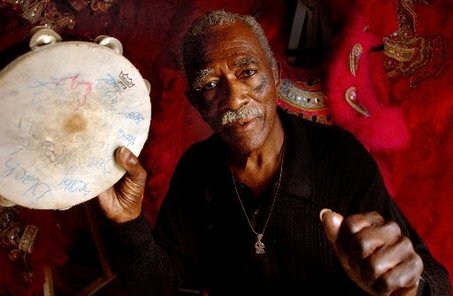 When Tootie was honored with a major exhibit at the New Orleans Museum of Art, I had the honor of writing the catalogue essay. If you are interested in more info about Tootie Montana and the Mardi Gras Indians go here to read the essay.
When Tootie was honored with a major exhibit at the New Orleans Museum of Art, I had the honor of writing the catalogue essay. If you are interested in more info about Tootie Montana and the Mardi Gras Indians go here to read the essay.
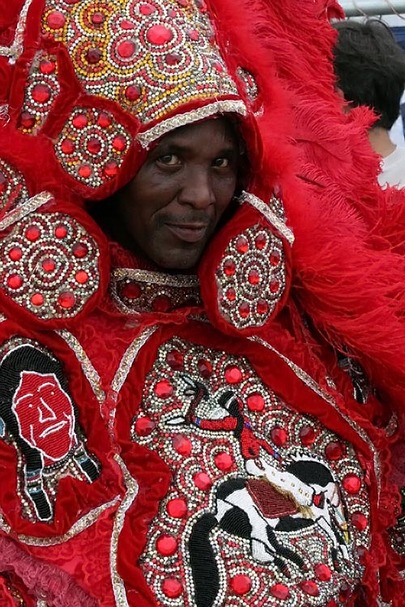 The general belief is that the Mardi Gras Indians formed to honor the alliance between Native Americans and runaway Africans. It is documented that in the early years of the Louisiana territory enslaved Africans rose up and joined with the Natchez Indians in a major rebellion in the mid 1700’s.
Indeed, Iberville, the founder of New Orleans noted in his journal that before Iberville even set foot in the New Orleans area, Indian scouts informed Iberville that there were blacks living in the swamps there and that those maroons (i.e. runaway Africans) refused to talk to any whites.
Those maroons probably came from the Florida area. During most of the 1700’s Florida was under the control of the Spanish who had decreed that any maroons who could escape and reach Florida could live free in Florida. A Maroon colony in Northern Florida called Mosa thrived for over a hundred years before being destroyed by the American military.
The general belief is that the Mardi Gras Indians formed to honor the alliance between Native Americans and runaway Africans. It is documented that in the early years of the Louisiana territory enslaved Africans rose up and joined with the Natchez Indians in a major rebellion in the mid 1700’s.
Indeed, Iberville, the founder of New Orleans noted in his journal that before Iberville even set foot in the New Orleans area, Indian scouts informed Iberville that there were blacks living in the swamps there and that those maroons (i.e. runaway Africans) refused to talk to any whites.
Those maroons probably came from the Florida area. During most of the 1700’s Florida was under the control of the Spanish who had decreed that any maroons who could escape and reach Florida could live free in Florida. A Maroon colony in Northern Florida called Mosa thrived for over a hundred years before being destroyed by the American military.
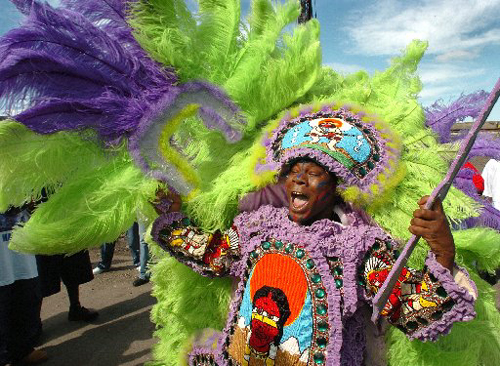 To this day the Mardi Gras Indians do not bow down to government authorities—they do not ask for parade permits and generally are not financially supported by government grants. Moreover, following Katrina, the city government has been harassing the Mardi Gras Indians and there have been several confrontations between Indians and the police.
After one particularly vicious attack by the police, a hearing was called in late July 2005, roughly a month before Katrina hit. The public meeting was held in the City Council chambers. Big Chief Tootie had a stroke and died while speaking out against police harassment. Tootie’s death while speaking out against police harassment electrified the black cultural community. The Mardi Gras Indians was always a serious movement and though smaller in number in the post-Katrina years, the Mardi Gras Indians remain the most militant and important expression of cultural self-determination in New Orleans.
If you listen closely you will hear constant references to fighting and refusing to bow down. Their funky music is about much, much more than simply singing and dancing. Mardi Gras Indian music is a sign of defiance and self-determination.
To this day the Mardi Gras Indians do not bow down to government authorities—they do not ask for parade permits and generally are not financially supported by government grants. Moreover, following Katrina, the city government has been harassing the Mardi Gras Indians and there have been several confrontations between Indians and the police.
After one particularly vicious attack by the police, a hearing was called in late July 2005, roughly a month before Katrina hit. The public meeting was held in the City Council chambers. Big Chief Tootie had a stroke and died while speaking out against police harassment. Tootie’s death while speaking out against police harassment electrified the black cultural community. The Mardi Gras Indians was always a serious movement and though smaller in number in the post-Katrina years, the Mardi Gras Indians remain the most militant and important expression of cultural self-determination in New Orleans.
If you listen closely you will hear constant references to fighting and refusing to bow down. Their funky music is about much, much more than simply singing and dancing. Mardi Gras Indian music is a sign of defiance and self-determination.
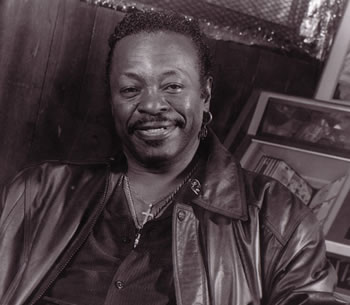 From a musical standpoint, Emile “Bo” Dollis is the most important Mardi Gras Indian. His vocal work is the major voice of the Mardi Gras Indians. Bo has an endless supply of lyrics and chants, many of them improvised as they parade through the streets. Bo Dollis is featured throughout the mixtape.
From a musical standpoint, Emile “Bo” Dollis is the most important Mardi Gras Indian. His vocal work is the major voice of the Mardi Gras Indians. Bo has an endless supply of lyrics and chants, many of them improvised as they parade through the streets. Bo Dollis is featured throughout the mixtape.
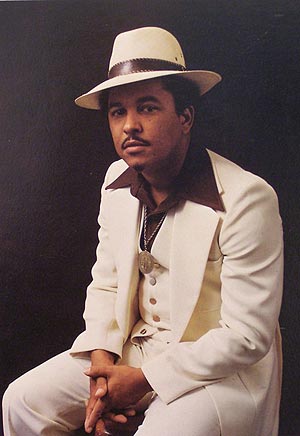 Wilson Turbinton, bka “Willie Tee,” is the most important musician in popularizing Mardi Gras Indian music. His sterling work with Bo Dolis and the Wild Magnolias is the best of the best.
Most of the “songs” are actually chants built on repeated refrains rather than popular song forms. Willie Tee was the most consistent in figuring out how to add jazz and funk elements to the chants. Other musicians such as Earl King, Professor Longhair, the Meters, the Neville Brothers, and Dr. John, all were able to produce one or two great songs but Willie Tee produced albums and established a musical subculture.
Wilson Turbinton, bka “Willie Tee,” is the most important musician in popularizing Mardi Gras Indian music. His sterling work with Bo Dolis and the Wild Magnolias is the best of the best.
Most of the “songs” are actually chants built on repeated refrains rather than popular song forms. Willie Tee was the most consistent in figuring out how to add jazz and funk elements to the chants. Other musicians such as Earl King, Professor Longhair, the Meters, the Neville Brothers, and Dr. John, all were able to produce one or two great songs but Willie Tee produced albums and established a musical subculture.
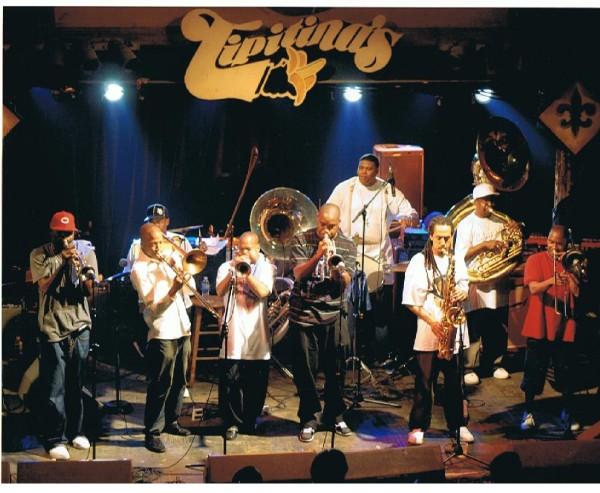 The combination of The Rebirth Brass Band and the Bo Dollis, particularly on the Super Sunday Showdown album is one of the few successful recordings that combine Mardi Gras Indians and brass band music. Although, from the outside, the two musical traditions might seem like a natural fit, successfully merging the two traditions is very difficult, especially because there is very little harmonic latitude even as there is poly-rhythmic complexity and melodic freedom.
The Mardi Gras Indian chants are built on a handful of songs that are used over and over again. Similarly the lyrics are generally limited. As exciting as the music can be, it’s fiendishly difficult to sustain. The fact that many of the lyrics have no English translation is another layer of complexity complicating the process of popularizing this distinctive music.
Through out the mixtape you will hear lyrics, riffs, chants and sometimes whole songs refashioned and repeated over and over. Fortunately boredom seldom sets in because the musicians and the Mardi Gras Indians are so adept at individualizing their musical expressions.
The combination of The Rebirth Brass Band and the Bo Dollis, particularly on the Super Sunday Showdown album is one of the few successful recordings that combine Mardi Gras Indians and brass band music. Although, from the outside, the two musical traditions might seem like a natural fit, successfully merging the two traditions is very difficult, especially because there is very little harmonic latitude even as there is poly-rhythmic complexity and melodic freedom.
The Mardi Gras Indian chants are built on a handful of songs that are used over and over again. Similarly the lyrics are generally limited. As exciting as the music can be, it’s fiendishly difficult to sustain. The fact that many of the lyrics have no English translation is another layer of complexity complicating the process of popularizing this distinctive music.
Through out the mixtape you will hear lyrics, riffs, chants and sometimes whole songs refashioned and repeated over and over. Fortunately boredom seldom sets in because the musicians and the Mardi Gras Indians are so adept at individualizing their musical expressions.
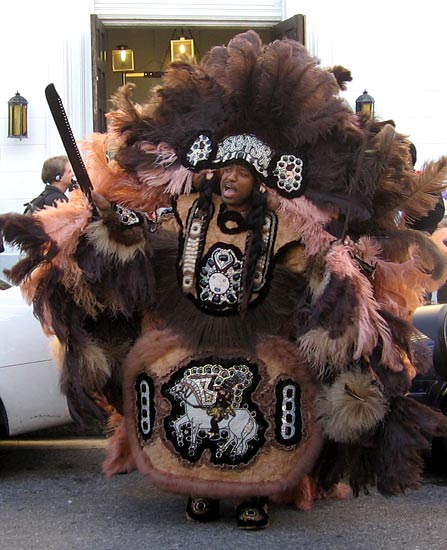 In New Orleans we are now working on the second hundred years of independent, self-determined, organized cultural expression during the Mardi Gras season.
The aftermath of Katrina has severely lowered and limited the black percentage of New Orleans’ population. We probably will never again see gangs of fifteen or twenty Mardi Gras facing off as they confront each other, singing and chanting, dancing and posing in battle stance as the two chiefs verbal assault each other and spread their feathers battling for aesthetic dominance; battling to see who’s the prettiest.
In New Orleans we are now working on the second hundred years of independent, self-determined, organized cultural expression during the Mardi Gras season.
The aftermath of Katrina has severely lowered and limited the black percentage of New Orleans’ population. We probably will never again see gangs of fifteen or twenty Mardi Gras facing off as they confront each other, singing and chanting, dancing and posing in battle stance as the two chiefs verbal assault each other and spread their feathers battling for aesthetic dominance; battling to see who’s the prettiest.
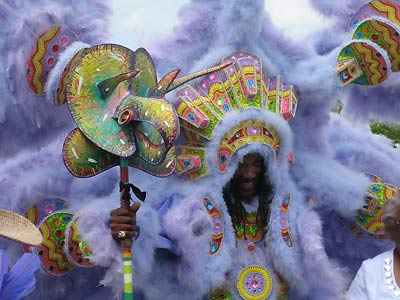 Those days of witnessing a sea of multicolored feathers coming down the street are no more. The Mardi Gras Indians are holding on but their ranks have been depleted.
The general population of working class blacks has been severely reduced by government inaction and, in some rather flagrant cases, by government harassment under the general rubric of improving the quality of life in the city.
While working class black folk have not been able to return in any significant numbers, the middle class blacks who have returned generally do not become stalwart, long term Mardi Gras Indians.
How long the Mardi Gras Indian culture will last is debatable. Just like there was a last of the Mohigans, there may be a last of the Wild Magnolias. Regardless of what the future holds, right now the culture is holding on. Right now you can still experience and participate in a Mardi Gras Indian procession.
Those days of witnessing a sea of multicolored feathers coming down the street are no more. The Mardi Gras Indians are holding on but their ranks have been depleted.
The general population of working class blacks has been severely reduced by government inaction and, in some rather flagrant cases, by government harassment under the general rubric of improving the quality of life in the city.
While working class black folk have not been able to return in any significant numbers, the middle class blacks who have returned generally do not become stalwart, long term Mardi Gras Indians.
How long the Mardi Gras Indian culture will last is debatable. Just like there was a last of the Mohigans, there may be a last of the Wild Magnolias. Regardless of what the future holds, right now the culture is holding on. Right now you can still experience and participate in a Mardi Gras Indian procession.
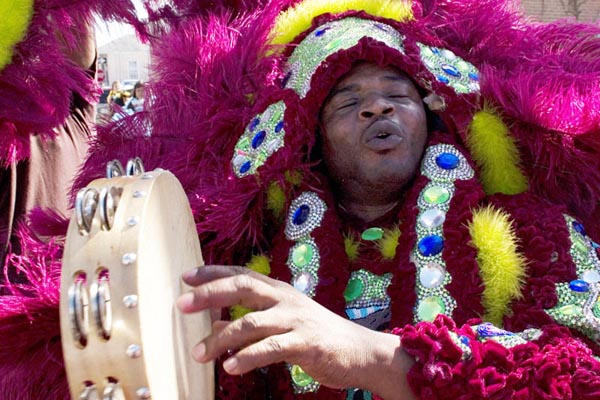 For those who are not fortunate enough to be able to live in New Orleans and to parade with the Indians, we share this mixtape. It’s just a little ta-ta in praise of the men and women of New Orleans who won’t bow down.
—Kalamu ya Salaam
For those who are not fortunate enough to be able to live in New Orleans and to parade with the Indians, we share this mixtape. It’s just a little ta-ta in praise of the men and women of New Orleans who won’t bow down.
—Kalamu ya Salaam
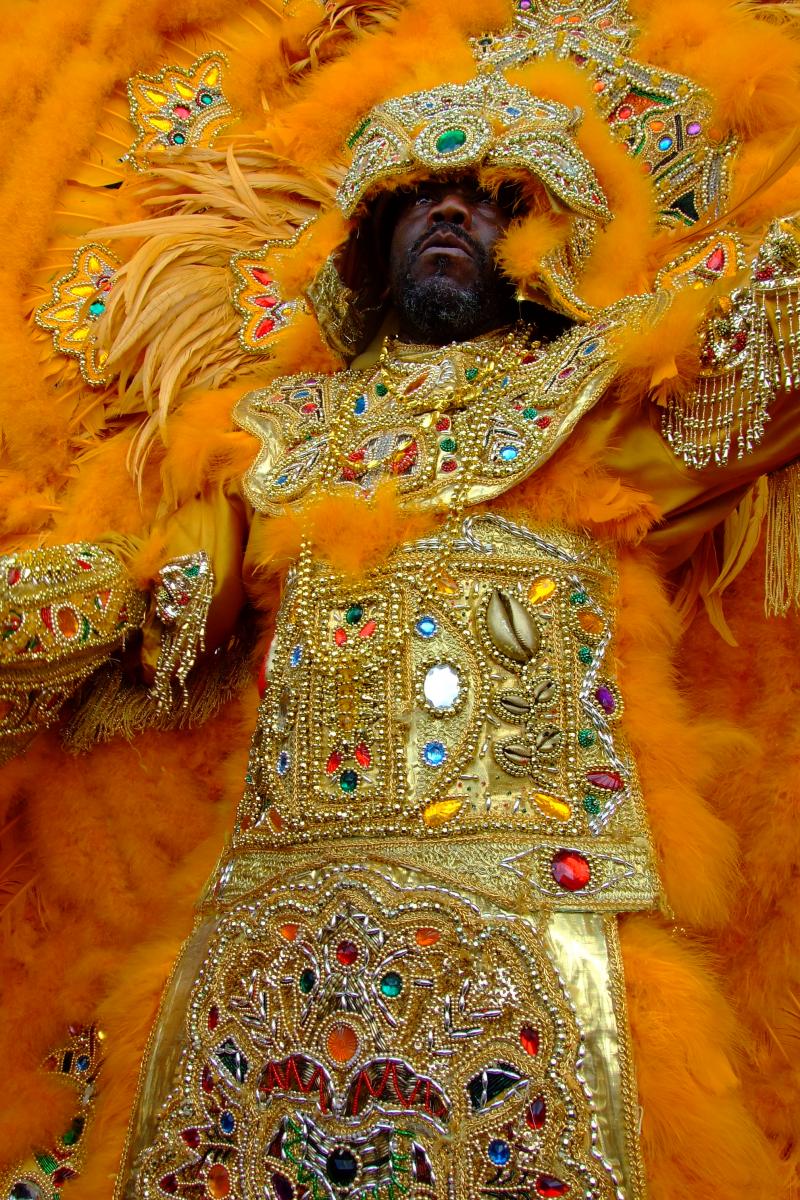 1. "Big Chief Part 1" - Professor Longhair - Mardi Gras In New Orleans
2. "Carnival Time" – Al Johnson - Mardi Gras In New Orleans (***Watch out! This is a completely different recording from the one listed above.)
3. "Mardi Gras Mambo" - The Hawketts - A History Of The Nevilles
4. "The Second Line" – Stop Inc. - New Orleans Ringtones
5. "Hey Pocky A-Way" - The Meters - Rhino On Da Bayou
6. "Mardi Gras In New Orleans" – Dirty Dozen Brass Band - This Is The Collection
7. "Carnival Time" - Bo Dollis & The Wild Magnolias - I'm Back . . . at Carnival Time
8. "Chockamo Feendo Hey" - Danny Barker And His Creole Cats - New Orleans Mardi Gras (out of print)
9. "Meet De Boys On The Battlefront" - Wild Tchoupitoulas - The Wild Tchoupitoulas
10. "Indian Red" - Cara Harrison - Her Name Is New Orleans
11. "Brother John" 3:37 - Wild Tchoupitoulas - The Wild Tchoupitoulas
12. "Handa Wanda" - Bo Dollis & The Wild Magnolias - 30 Years.. And Still Wild!
13. "White Eagles Indian Practice" - Bo Dollis & The Wild Magnolias - 30 Years.. And Still Wild!
14. "Indian Red" - The Golden Eagles Featuring Monk Boudreaux - Lightning & Thunder
15. "Mardi Gras Make Ho Na Nae" - Bo Dollis & The Wild Magnolias - 30 Years.. And Still Wild!
16. "Yella Pocahontas" - Champion Jack Dupree - Super Sunday Showdown
17. "Hell Out The Way" - Bo Dollis & The Wild Magnolias - 30 Years.. And Still Wild!
18. "New Suit" - The Wild Magnolias - They Call Us Wild
19. "Let's Go Get 'Em" - Bo Dollis and Monk Boudreaux - Super Sunday Showdown
20. "Shoo-Fly" - Bo Dollis and Monk Boudreaux - Super Sunday Showdown
21. "Do Whatcha Wanna Pt.3" - Rebirth Brass Band - Rhino On Da Bayou
22. "Oops Upside Your Head" - Bo Dollis & The Wild Magnolias - Super Sunday Showdown
23. "Mardi Gras In New Orleans" - Professor Longhair - A New Orleans Mardi Gras, Vol. 1
24. "Ho Na Nae" - Bo Dollis & The Wild Magnolias - 30 Years.. And Still Wild!
25. "Two Way Pak E Way" - The Wild Magnolias - They Call Us Wild
26. "Big Chief - Part 2" - Professor Longhair - Mardi Gras In New Orleans
1. "Big Chief Part 1" - Professor Longhair - Mardi Gras In New Orleans
2. "Carnival Time" – Al Johnson - Mardi Gras In New Orleans (***Watch out! This is a completely different recording from the one listed above.)
3. "Mardi Gras Mambo" - The Hawketts - A History Of The Nevilles
4. "The Second Line" – Stop Inc. - New Orleans Ringtones
5. "Hey Pocky A-Way" - The Meters - Rhino On Da Bayou
6. "Mardi Gras In New Orleans" – Dirty Dozen Brass Band - This Is The Collection
7. "Carnival Time" - Bo Dollis & The Wild Magnolias - I'm Back . . . at Carnival Time
8. "Chockamo Feendo Hey" - Danny Barker And His Creole Cats - New Orleans Mardi Gras (out of print)
9. "Meet De Boys On The Battlefront" - Wild Tchoupitoulas - The Wild Tchoupitoulas
10. "Indian Red" - Cara Harrison - Her Name Is New Orleans
11. "Brother John" 3:37 - Wild Tchoupitoulas - The Wild Tchoupitoulas
12. "Handa Wanda" - Bo Dollis & The Wild Magnolias - 30 Years.. And Still Wild!
13. "White Eagles Indian Practice" - Bo Dollis & The Wild Magnolias - 30 Years.. And Still Wild!
14. "Indian Red" - The Golden Eagles Featuring Monk Boudreaux - Lightning & Thunder
15. "Mardi Gras Make Ho Na Nae" - Bo Dollis & The Wild Magnolias - 30 Years.. And Still Wild!
16. "Yella Pocahontas" - Champion Jack Dupree - Super Sunday Showdown
17. "Hell Out The Way" - Bo Dollis & The Wild Magnolias - 30 Years.. And Still Wild!
18. "New Suit" - The Wild Magnolias - They Call Us Wild
19. "Let's Go Get 'Em" - Bo Dollis and Monk Boudreaux - Super Sunday Showdown
20. "Shoo-Fly" - Bo Dollis and Monk Boudreaux - Super Sunday Showdown
21. "Do Whatcha Wanna Pt.3" - Rebirth Brass Band - Rhino On Da Bayou
22. "Oops Upside Your Head" - Bo Dollis & The Wild Magnolias - Super Sunday Showdown
23. "Mardi Gras In New Orleans" - Professor Longhair - A New Orleans Mardi Gras, Vol. 1
24. "Ho Na Nae" - Bo Dollis & The Wild Magnolias - 30 Years.. And Still Wild!
25. "Two Way Pak E Way" - The Wild Magnolias - They Call Us Wild
26. "Big Chief - Part 2" - Professor Longhair - Mardi Gras In New Orleans
This entry was posted on Monday, February 23rd, 2009 at 2:26 pm and is filed under Classic. You can follow any responses to this entry through the RSS 2.0 feed. You can leave a response, or trackback from your own site.
4 Responses to “VARIOUS ARTISTS / “Mardi Gras Mixtape””
February 24th, 2009 at 12:31 pm
This music makes me think of lawlessness. Not lawlessness in terms of anarchy, crime, or violence. Lawlessness of the spirit. A plastic cup of alcohol, arms loosely held around someone’s waist and swaying down the middle of the street. A day of sanctioned no rules, a day when you’re supposed to rip up the rules and throw them out. I’m writing this from work in New York, on Mardi Gras day when everybody at home is not at work and I can’t line up my rental car for when I come in town in a few days because everyone is either chasing a plastic cup or drinking out of a plastic cup or avoiding plastic cups… but the one thing they aren’t doing is working. Because laws are about somebody else… and lawlessness is all about you. What do you want to do today? Do what you wanna!
November 18th, 2009 at 4:17 am
Actually i think, that the whole Wild Tchoupitoulas Record with the Meters, the Nevilles and “Naomi” stands well up to the Turbington Magnolias.
I did see the Magnolias in Rennes some 20 Years ago, rockin the House for more then 2 Hours partly with the help of the Rebirth Brass Band.
The Rounder Stuff sound rather more like Field-Recordings. No match to the Concert or the “Zigaboo” Meter-Modulations.
Thanks
August 16th, 2014 at 7:00 am
Thank you for this lesson. Rich and deeply moving unknown history. This non-New Orleanian thanks you.
Leave a Reply
| top |